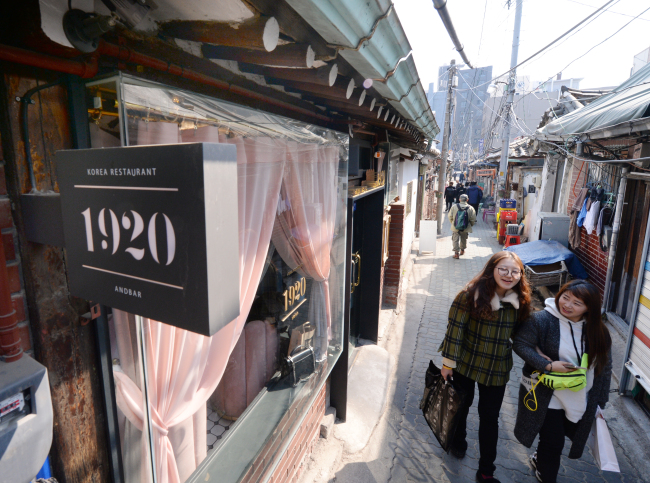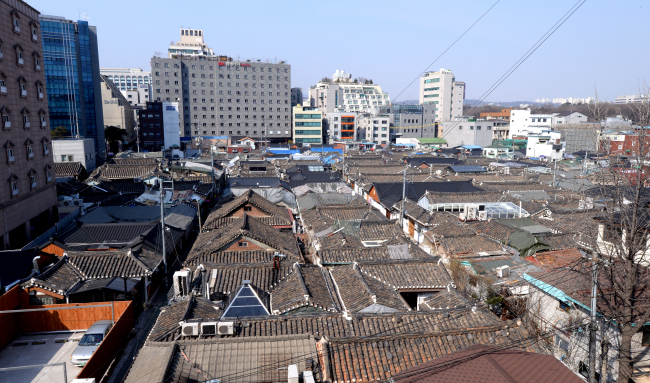Seoul is a vibrant megalopolis with modern high rises crowding the city’s major arteries. Nestled among the gleaming buildings are maze-like alleys that appear to have escaped the passage of time. The Korea Herald explores the many nooks and crannies of Seoul, proclaimed the capital of Joseon in 1392, that reveal a multifaceted city. -- Ed.
Walking out of the Jongno 3-ga Station in central Seoul, you will find vibrant streets of jewelry shops, tourists, couples on dates, street vendors and movie theaters.
Confused, you may doubt your friend’s advice to check out a village of hanok -- traditional Korean houses -- at Ikseon-dong, Jongno-gu.
Yet, lurking within the modern part of the town are alleys lined tightly with hanok that have preserved their traditional exterior.
The hanok village at Ikseon-dong is rarely short of wide-eyed young visitors looking for diversion from their everyday lives.
“My friend told me about this place. It’s very cool that there is a hanok town right in the middle of the city,” said Kim Hee-won, 23, who was looking at the map of Ikseon-dong with two friends.
 |
Restaurant “1920” located at the hanok village in Ikseon-dong, Jongno-gu, Seoul. (Park Hyun-koo/The Korea Herald) |
Lining the alleys are small shops catering mostly to young people’s tastes.
Anyone feeling nostalgic may want to step into Vintage Bonnie, filled with quirky items from your childhood days.
A romantic looking to impress a special someone may want to slip into Madang Flowers & Cafe. The scent of fresh flowers welcome visitors as they step into the bright, cozy venue.
You could have them arrange flowers or even take classes in flower arrangement.
If pleasant smells are your thing, you may want to pay a visit to Proust Scent Shop & Tea Cafe. Located smack in the middle of the hanok enclave, the modern interior allows you to relax while enjoying tea and the aroma it offers and you can even concoct your own perfume.
A notice posted outside the Yeoldudal fusion restaurant reminds you that the village is a home for many people, and urges you to act accordingly.
But some residents say they do not mind the flock of young people visiting their neighborhood.
“I like it better now that it’s full of young people. They say sorry (when they’re noisy) and we mind our own business,” said a 79-year-old resident who shyly refused to give her name. “There used to be a bunch of homeless people around here. At least the visitors don’t steal your stuff.”
 |
The hanok village in Ikseon-dong, Jongno-gu, Seoul (Park Hyun-koo/The Korea Herald) |
Regardless of what the sight of hanok may suggest, the history of Ikseon-dong is shorter than you may think.
Back in the 1920s when Korea was under Japanese colonial rule, the Japanese were expanding their territory deep within the country’s capital, then-called Gyeongseong.
Concerned that the proliferation of Japanese-style buildings would squash the Korean traditional architecture, real estate developer Jeong Se-gweon planned to establish hanok villages in a number of areas in the city. These included what would later come to be known as Bukchon and Ikseon-dong.
“His (Jeong’s) plan was to build houses for Koreans to ensure they had a place to live,” wrote Kim Kyung-min, a professor of environmental studies at Seoul National University in his book “Construction King Creates Gyeongseong.“
“Jeong may have not realized it, but what he did was initiate urban planning in a way that did not even exist at the time. It was a construction project that was way ahead of his time.”
While retaining the traditional hanok designs to an extent, the houses were modernized to install features like water pipes and tiles on the kitchen floor. But as wealth shifted toward other parts of Seoul, the old buildings became home to households with limited income, especially since the 1970s.
This changed around 2015, when the village gained a reputation as a place of nostalgia. Young people began coming to the area, as homes gave way to stores targeting the newfound tourists.
Rent began to climb as a result, and some residents who had lived there for years were forced to leave.
“There are hardly any residences left, only stores remain here,” said Hwang Jeong-sun, 80, who had lived in Ikseon-dong for 10 years. “I used to live here, but the landlord sold the house.”
There are concerns that the area may fall victim to gentrification, a process that has been the case in other urban areas that underwent revival in recent years.
Seoul city government is reportedly mulling measures to preserve the unique character of Ikseon-dong, which includes designating it as an official hanok village like Bukchon Hanok Village in the northern part of Jongno-gu.
By Yoon Min-sik
(
minsikyoon@heraldcorp.com)









